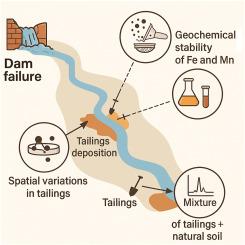Distribution of trace elements in the tailings of the B1 dam, in the Córrego do Feijão mine, and in soils affected after the dam breach
IF 3.4
3区 地球科学
Q1 GEOCHEMISTRY & GEOPHYSICS
引用次数: 0
Abstract
The chemical, physical, and mineralogical characteristics of tailings from the B1 dam at the Córrego do Feijão Mine were evaluated to understand the distribution and potential mobility of trace elements, especially in tailings with original characteristics without incorporation of other materials or debris, information little referenced in the literature. Twenty samples of dam tailings (RJ) were collected directly from the B1 original reservoir. Seven samples of substrates potentially affected (SPA) were obtained from the Ferro-Carvão stream basin in areas affected by the dam breach (tailings potentially mixed with soil or other debris).
Unaffected soil samples (SNA, without any contribution of tailings) were also collected in the vicinity of the affected areas. The soils were collected to help understand how the original characteristics of the tailings were modified by their incorporation throughout the affected area in the Ferro e Cargo stream basin. Mineralogical assessments using techniques such as X-ray diffraction, SEM-EDS and Advanced Mineral Identification and Characterization System (AMICS) revealed predominant iron oxide minerals (hematite, goethite, and magnetite) in the tailings, with varying proportions of quartz, kaolinite, and feldspar. Sequential extraction protocols indicated that basically iron and manganese were primarily associated with crystalline oxides and hydroxides, suggesting stability related to trace metals. The results obtained in this study show that the substrates potentially affected by the collapse of the B1 tailings dam along the Ferro-Carvão stream basin exhibit physical, chemical, and mineralogical characteristics with a transitional profile between those of the remaining tailings in the B1 dam and the unaffected soils. The findings underscore the importance of comprehensive geochemical characterization to assess the environmental risks posed by mine tailings and to evaluate trace element mobility in complex tailings environments.

B1坝尾矿、Córrego飞焦矿尾矿及溃坝后受影响土壤中微量元素的分布
通过对Córrego do feij o矿B1坝尾矿的化学、物理和矿物学特征进行评价,了解尾矿中微量元素的分布和潜在迁移率,特别是在未掺入其他物质或碎屑的尾矿中,这些信息在文献中很少提及。从B1原库直接采集了20份尾矿样品。从受溃坝影响地区的铁-卡佛 o河流域获得了7个潜在受影响基质样本(尾矿可能与土壤或其他碎屑混合)。还在受影响地区附近收集了未受影响的土壤样品(SNA,没有任何尾矿贡献)。收集土壤是为了帮助了解尾矿的原始特征是如何通过在整个Ferro e Cargo流流域的受影响区域中加入而被改变的。利用x射线衍射、SEM-EDS和先进矿物识别和表征系统(AMICS)等技术进行的矿物学评估显示,尾矿中主要的氧化铁矿物(赤铁矿、针铁矿和磁铁矿),石英、高岭石和长石的比例不同。顺序提取方案表明,基本上铁和锰主要与结晶氧化物和氢氧化物有关,表明稳定性与微量金属有关。研究结果表明,铁- carv o流域B1尾矿坝崩塌可能影响的基质表现出物理、化学和矿物学特征,介于B1坝剩余尾矿和未受影响土壤之间的过渡剖面。研究结果强调了综合地球化学表征对评价尾矿环境风险和评价复杂尾矿环境中微量元素迁移率的重要性。
本文章由计算机程序翻译,如有差异,请以英文原文为准。
求助全文
约1分钟内获得全文
求助全文
来源期刊

Applied Geochemistry
地学-地球化学与地球物理
CiteScore
6.10
自引率
8.80%
发文量
272
审稿时长
65 days
期刊介绍:
Applied Geochemistry is an international journal devoted to publication of original research papers, rapid research communications and selected review papers in geochemistry and urban geochemistry which have some practical application to an aspect of human endeavour, such as the preservation of the environment, health, waste disposal and the search for resources. Papers on applications of inorganic, organic and isotope geochemistry and geochemical processes are therefore welcome provided they meet the main criterion. Spatial and temporal monitoring case studies are only of interest to our international readership if they present new ideas of broad application.
Topics covered include: (1) Environmental geochemistry (including natural and anthropogenic aspects, and protection and remediation strategies); (2) Hydrogeochemistry (surface and groundwater); (3) Medical (urban) geochemistry; (4) The search for energy resources (in particular unconventional oil and gas or emerging metal resources); (5) Energy exploitation (in particular geothermal energy and CCS); (6) Upgrading of energy and mineral resources where there is a direct geochemical application; and (7) Waste disposal, including nuclear waste disposal.
 求助内容:
求助内容: 应助结果提醒方式:
应助结果提醒方式:


